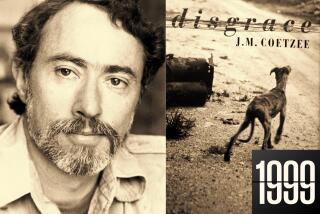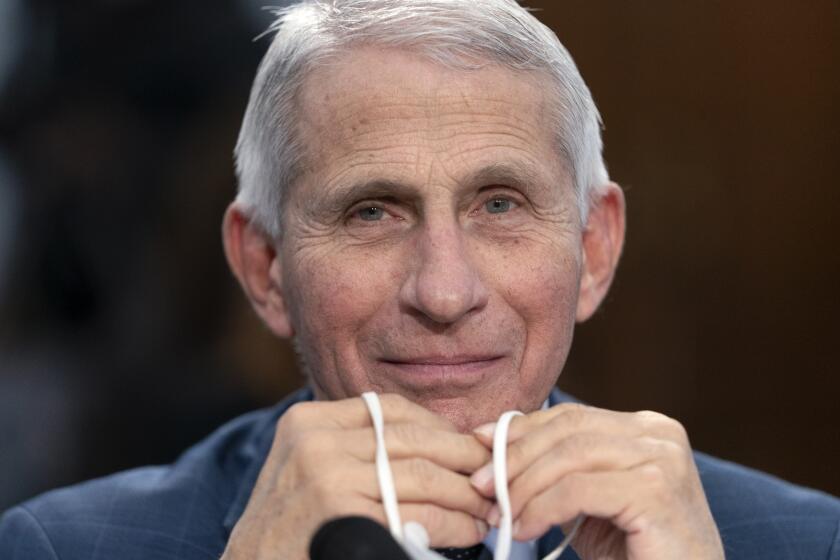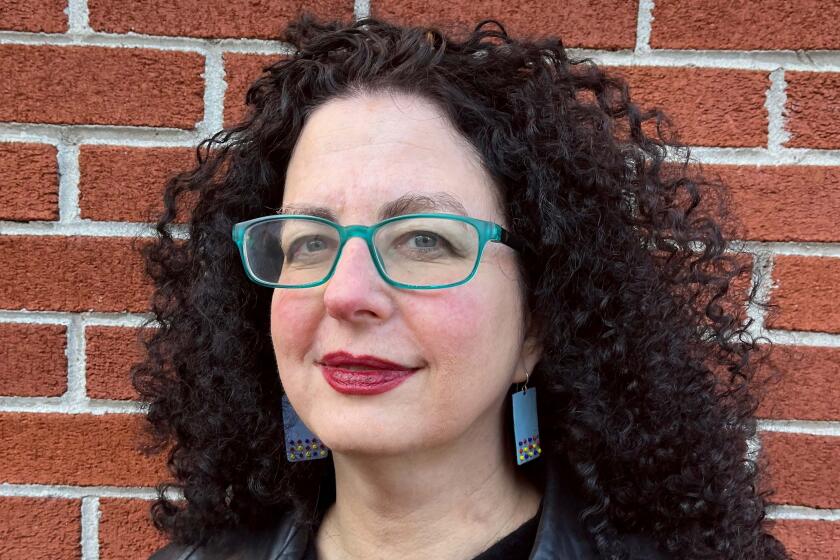Searching for the 6-Year-Old in All of Us : Eric Carle, Author of ‘The Very Hungry Caterpillar,’ Knows That ‘Childlike’ Does Not Mean ‘Childish’
Most of us, if we are lucky, savor a secret slice of childhood, and when no one else is looking, we sneak back for a visit. We climb invisible trees. We garb ourselves in the raiments of youth. We summon a treasured friend, a trusted companion--an adult, even, who somehow made the moment magic.
Eric Carle, certainly, is one who finds it effortless to spiral back six decades. White-haired and bearded, he wears trifocal glasses and carries a belly that bespeaks a lifetime of good eating. In an instant, he is 6 years old.
He is in Syracuse, N.Y., exploring the glories of an anthill with his father. He is in his favorite classroom, splashing great globs of color on a giant sheet of paper. He is sharing a warm loaf of fresh-baked bread with the girl across the street.
“I often think of myself when I was little,” Carle said. “I had a lot of feelings, philosophical thoughts--at the age of 6! The only way I got older and wiser was that I got better trained,” he went on. “But that brain and soul were at their peak.”
And so it is that Carle has turned his talents to nourishing the brains, souls and spirits of children 6 and younger. In words and in pictures, he engages young minds in the mystery of renewal. He eases the ache of separation. He hands children hope. He encourages work, extols love, celebrates companionship.
Carle’s best-known title, “The Very Hungry Caterpillar” (Philomel Books, 1969), celebrated its 25th anniversary last year, placing it among the handful of books by Dr. Seuss, Margaret Rey and a select few other young people’s authors whose books have been passed from one post-World War II generation to another. The insects in his titles--caterpillars, crickets, spiders, fireflies--serve as metaphors for children to whom an anthill might well be a world unto itself. The spider that spins so industriously teaches a child about work. The cricket falls in love. The caterpillar sheds its skin, a miracle of renewal.
Long before they can read, children are drawn to Carle’s deceptively simple stories. They poke their fingers through holes provided for small, stubby hands--unaware that in the process, they are learning such skills as counting. The formula clearly works, for Carle’s titles have sold a stunning 25 million copies combined. “The Very Hungry Caterpillar” alone has sold more than 12 million copies, a figure most authors would consider remarkable and enviable, though perhaps not in that order.
Carle’s books come out so often that even he loses track of them. He switches publishers from time to time, jumping to Simon & Schuster, for example, to produce this year’s “Walter the Baker”--an anti-imperialistic tract that ridicules the vagaries of the ruling class.
“His books are childlike but not childish--which is a wonderful thing to do. That gives a child dignity,” said Candace Lynch, book manager at the San Marino Toy and Book Shop. “They invite the child right into the book,” she said. “They are interactive, way before that was ever a term.”
Carle has lost count of the precise number of books he has written, but usually rounds it off to three dozen. He has illustrated many others, beginning with Bill Martin Jr.’s “Brown Bear, Brown Bear, What Do You See?” (Henry Holt & Co., 1967). “That turned me around,” said Carle, who until then had worked in advertising and promotion. “I decided I could tell stories.”
Providing the art work for other authors convinced Carle that few writers communicate visually. “Mine, the art and the pictures, they’re all tied in together,” Carle said. “I do picture books, not children’s books. They are stories with pictures.”
They are also books written in large part for a 6-year-old Eric Carle. “I don’t think of anyone but myself when I write,” he said. He has no literary role models, and little interest in the work of other authors. He pleads ignorance to any great knowledge of the complexities of children’s literature. But all the while, as he is working, “I have respect for the little Eric that I was. I have respect for all the little Erics out there.”
That small boy was born to German immigrants who came to America in pursuit of plenty and prosperity. His father, chafing in a low-ranking civil service job in the family home of Stuttgart, was 21 when he made his way to Syracuse in 1925. There the frustrated artist landed a job spray-painting washing machines. His sweetheart, Carle’s mother, followed, working as a chambermaid until their son was born.
He remembers most of all nature expeditions with his father, smiling still at “the excitement of lifting stones or peeling back the bark of dead trees to discover the living things that crawled, crept and scurried about there.” Once he picked up a snake and was shocked when those around him recoiled at his squirming trophy.
Even today, his books carry small science messages. For example, his new book “The Very Lonely Firefly” (Philomel Books), begins with the admonition: “Fireflies are not flies, but soft-bodied beetles. They have a luminous, light-giving organ which blinks on and off in the night to attract other fireflies.”
Raised with a healthy regard for authority, his mother assumed when the teacher called to arrange a conference that her son must be misbehaving in class. Instead, his first-grade teacher wanted to tell his parents that the boy showed an unusual flair for drawing and painting.
“I don’t remember the name of the teacher, or the school,” Carle said, grateful nonetheless for the early encouragement. “All I remember is a big room with a lot of light.”
He offered this recollection while standing in his studio, a big room with a lot of light. It occupies the third floor of an old warehouse on the main street of this western Massachusetts community. Carle designed the space, vaulting the high ceilings and punching through skylights and clerestory windows. Extensive wall space serves as a gallery; the polished wooden floor a work space for the bright collages that become the illustrations of his books.
“So a friend saw my studio and said ‘Look at you, you’ve re-created the first grade,’ ” Carle recalled, laughing.
It seems a reasonable time for Carle to have frozen his own exuberant memories. He was 7 when his parents packed up and moved the family back to Germany. It was an uncommon gesture of reverse immigration, brought on mainly by his mother’s homesickness.
It was also terrible timing, for soon thereafter, Carle’s father was drafted into the German army. His son was 18 years old when he returned from a Russian prison camp, “80 pounds; totally devastated, physically and emotionally,” Carle said. “We never reconnected after that.”
Carle was 22 when he headed back to the United States. “I had $40 in my pocket and a good portfolio of my work. And you know what? I thought I was rich.” Within a week, he had a job as an artist in a newspaper’s promotion office.
Raising his daughter Cirsten, now 37, and son Rolf, now 35, “I had the average interests of a father in those years. I would occasionally tell my wife to buy them a book. But I don’t remember reading to them.”
So in creating picture stories, he harks back to the tales his father told. He keeps them simple--an absolute maximum of 200 words, “half of which are repeats”--but never simplistic. “My books are not didactic,” he insisted--educational, occasionally, “of course, but that is not the driving force.”
Some ideas live with him for years before making their way into eight-page mock-ups that may or may not graduate into full-fledged books. “You think about it, you forget about it, you obsess about it,” he said. “I get depressed a lot, and that seems to precipitate things. My wife sees my mood darken and says, ‘Uh-oh, you’re ready to do a book.’ ”
Carle can only chuckle when the uncomplicated quality of his books is confused with shortcut writing. “I’ve had friends say, ‘I think I’ll go home and write a kiddie book this weekend,’ ” Carle said. “I say, ‘good luck.’
“I devote my entire life to this,” he said, spreading his hands out to encompass the art on the walls. “This is my life.”
More to Read
Sign up for our Book Club newsletter
Get the latest news, events and more from the Los Angeles Times Book Club, and help us get L.A. reading and talking.
You may occasionally receive promotional content from the Los Angeles Times.






